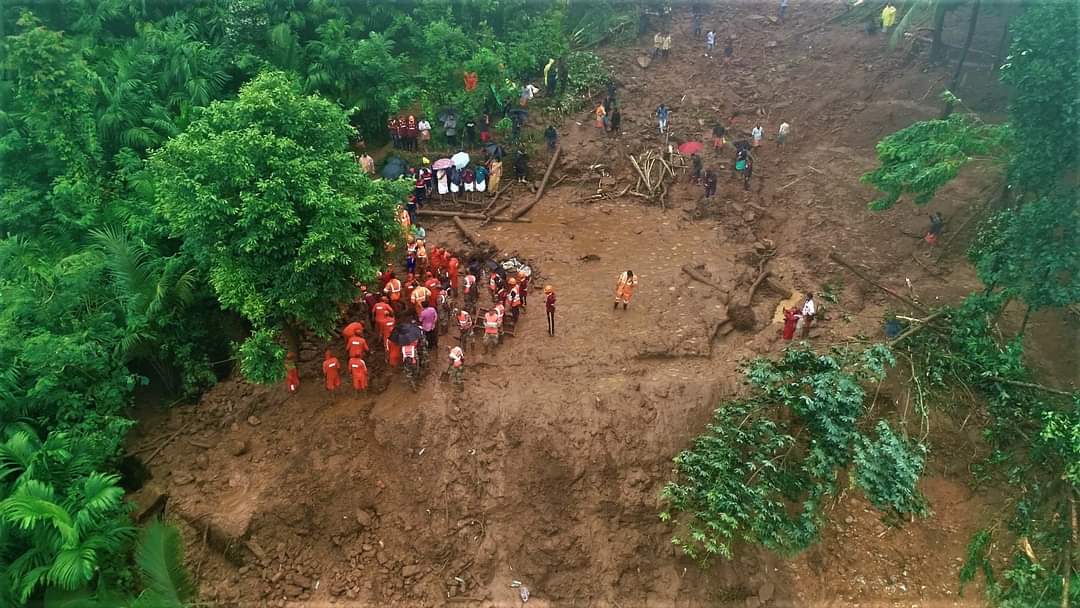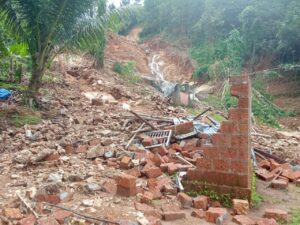A living lab for disaster management is a collaborative ecosystem where innovative solutions are conceived, tested, and refined in real-world conditions.
Published Jul 28, 2024 | 3:00 PM ⚊ Updated Jul 28, 2024 | 3:00 PM

Multiple landslides hit the Kanichar Grama Panchayat in Kannur in 2022. (Sourced)
A Kerala grama panchayat, grappling with a history of landslides, is set to become a national trailblazer in disaster management by unveiling the ‘living lab’ approach.
After enduring nearly two dozen landslides in 2022 alone, the Kanichar Grama Panchayat in Kannur will embark on this ambitious project to equip the community to withstand them.
Adding to this groundbreaking initiative, the panchayat is also gearing up to install the state’s inaugural landslide early-warning system with the help of IIT-Roorkee.
A living lab for disaster management is a collaborative ecosystem where innovative solutions are conceived, tested, and refined in real-world conditions. By working closely with affected communities, experts co-create strategies to prevent, mitigate, and respond to disasters.
In 2022, multiple landslides resulted in the loss of lives, and livelihoods, besides damaging properties.

More than 20 landslides have been recorded in the panchayat. Of this, a majority occurred in August-September 2022. (Sourced)
It was estimated that more than 20 landslides have been recorded in the panchayat. Of this, a majority occurred between August and September 2022.
After the landslides, the panchayat unanimously requested a direct investigation by the Kerala State Disaster Management Authority (KSDMA) into the causes. The agency then conducted a detailed investigation.
Based on its findings, in June 2023, considering the disaster impacts in Kanichar as a special case, the government declared it a specific disaster.
The KSDMA study pinpointed several factors contributing to the landslides, including weathered rocks, thin soil cover, and rampant deforestation.
The presence of two quarries in the vicinity is said to have exacerbated the situation, leading to soil erosion, water contamination, and environmental degradation.
In its report submitted to the State Level Environment Impact Assessment Authority (SEIAA) in July 2023, KSDMA highlighted that a ‘field study revealed that even though hard rocks are strong and stable, due to weathering and fracturing it has become very fragile and with several fractures.’
Pinpointing the role of the quarry units, the report stated, “It is reported that up to 31st July 2022, the mine was operative and conducted several blasts. It was also reported that the blast holes were dug to more than the stipulated depth, even up to 8 to 12 feet. The effect of blasting was reported to be severe under such conditions.”

Around 90 percent of the landslides that occurred during the 2022 rainy season were within a two-km radius of the quarry unit. (Sourced)
It further added, “The torrential rain during 2018-19 and 2019-20 oversaturated the soil cover and the highly fractured/jointed basement rock. It appeared that the area became vulnerable due to heavy mining activity during this period. The fractures and joints triggered the 2022 landslides.”
The report said around 90 percent of the landslides that occurred during the 2022 rainy season were within a two-km radius of the quarry unit.
The SEIAA, while rejecting the proposal of operating the quarry, noted that “in such an area which has become very fragile, the mining activity has to be restricted. It is categorically stated that there is every possibility of the continuation of such disasters as the land lost its stability.”
Talking to South First, Amrutha, a hazard analyst with the KSDMA said, “A novel approach to disaster management is set to be implemented in Kanichar panchayat. The panchayat will be transformed into a living lab, a globally recognized concept, aimed at building resilience against various challenges.”
The ambitious project will be a collaborative effort between the government and private sector. The core objective is to fortify the community’s capacity to withstand social, environmental, disaster, and financial crises, she said.
Under the living lab approach, disaster-related challenges faced by the community will get thoroughly analyzed. Then, to share knowledge and perspectives diverse stakeholders will be brought together.
This collaboration and experimentation are likely to result in the developing of innovative solutions. Then comes the part of implementing the solutions in a real-world setting and gathering feedback. If successful, the solution will be replicated in other areas.
It is learnt that a dedicated Resilient Centre will be established within the panchayat to spearhead this initiative. A series of projects will be undertaken to achieve the goal of making Kanichar a resilient panchayat.
According to Antony Sebastian, president, Kanichar grama panchayat, a discussion was earlier held with the panchayat committee and KSDMA. The meeting discussed various vulnerabilities and the need to have a risk-informed approach to resilient development was highlighted.
He also added that within two weeks, the initiative be rolled out in the panchayat.
“As it’s a new initiative much is not known about it. However, we were told that the KSDMA will guide us towards a resilient pathway of development. Also, as part of the living labs approach, various interventions are to be planned and implemented,” Sebastian told South First.
According to a government-approved proposal, the interventions are grouped under four categories:
Operational: Optimizing existing governance framework in the panchayath for ensuring resilient development, ensuring risk-informed spatial master plan and local action plan on climate change
Financial: Optimizing resource allocation based on risk information and, converging and mobilising financial resources from own/development funds of the panchayath, national/state DRMF, NAFCC, NABARD, CSR, CER, etc.
Policy: Develop and adopt a risk-informed spatial development plan
Future: Ensuring climate change adaptation and long-term risk transfer
Approving the proposal, Tinku Biswal, principal secretary (Revenue), noted that ‘the living lab approach in Kanichar is for supporting local government in building resilience to prepare and respond to potential disasters.’
For the smooth implementation of the ‘living lab’ approach, a dedicated Resilience Officer will be appointed. The officer will work closely with the panchayat, Kannur District Disaster Management Authority, KSDMA, and Kerala Climate Change Adaptation Mission.
Meanwhile, sources said Kerala will soon set up another living lab at Kozhikode’s Moodadi grama panchayat after it approached KSDMA to help make it heat-resilient.
(Edited by Majnu Babu)
(South First is now on WhatsApp and Telegram)
